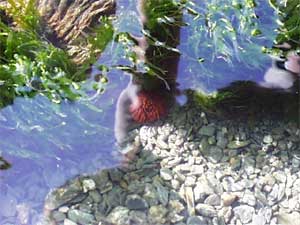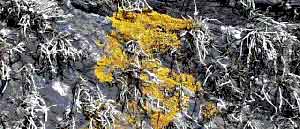Field Studies
Outdoor Alternative is used by a number of groups who have realised the potential of the Centre and local area for providing interesting and relevant opportunities for the study of a number of subjects. Principally: Biology, Geography, Geology, Leisure and tourism, Sports Science and Outdoor Education.
Biology Field Studies Opportunities at Outdoor Alternative

Courtesy: Dr. Barry Meatyard, University of Warwick (Head of Biology Warwick School - 1994).
The Centre is ideally situated for a variety of coastal habitats:
a) Typical rocky shores around Porth Gorslwyn with a variety of degree of exposure within easy walking distance (5min). Safe access with a good range of typical species. Worthwhile from Easter throughout the year.
b) Sandy beach At Borthwen. Good for zonation of worms at low tide. Throughout the year.
c) Whole area shows typical maritime clifftop flora in late spring and early summer.
d) Four Mile Bridge offers good plankton collecting site - a net can be left to sample several hours of water flow.
e) Also at Four Mile Bridge is good access to salt marsh habitat.
f) Access to other maritime habitats by road is convenient - good sand dunes at Aberffraw or Newborough Warren (best in early summer), also shingle bay at Cemlyn (tern colony).
g) Easy access to several sites of high conservation value with good relations with wardens. e.g.. South Stack RSPB reserve is an SSI important for not only its birds (chough, nesting seabirds and peregrines) but also for heathland habitat supporting two rare plants and a good invertebrate community; and Penrhos, a coastal park area, where much creative management, planting schemes and the like have provided a rich natural history resource. These two sites provide excellent examples and study opportunities for the conservation options for A level Biology.
h) There are several other sites of biological interest. Parys Mountain is an old copper mine where the settling ponds show a range of very low pH but colonisation by a number of species. The spoil heaps are colonised by heather which has a copper tolerant mycorrhizal fungal association. The Sea Zoo is a worthwhile visit for Biologists at all levels. The Menai Straits are well known for their biological interest.
i) Perhaps as important is the flexibility of the Centre's buildings for both laboratory work and opportunities for classroom activities.
Additionally the pond in the Centre grounds has proved an excellent site for plant, animal and insect work for undergraduate biologists.
The rocks around Rhoscolyn, designated a Site of Special Scientific Interest, provide one of the most visited geological localities in Great Britain. From the Field Centre one can walk directly on to easily accessible coastal exposures of deformed sedimentary rocks that show spectacular cascades of folds and associated cleavages. The sediments have been folded several times, so that one may study the effects of one fold being superimposed on another.
The most famous exposures lie in the core of the Rhoscolyn Anticline, a huge, arch-shaped fold exposed in the cliffs just 15 minutes walk along the coast from Outdoor Alternative. The nearest rocks in the UK that come even close to matching such splendid exposures are those in the highlands of Scotland, so it is unsurprising that the area is so popular with universities and school from all over England and Wales. In particular, the ground is perfect for detailed mapping exercises and teaching students how to measure folds in the field.
For the geological specialist, within a kilometer of the field centre one can visit polydeformed metapsammites, metapelites, quartzites, serpentinite, metagabbro and metabasalt, as well as fine examples of late basic dykes that cut through the metamorphic complex. Within an easy drive of Holy Island, the famous ‘Monian’ rocks of Anglesey preserve high grade sillimanitic metapelites and amphibolites, calc-alkaline granitoid rocks, the internationally known Gwna Melange (the first melange ever described), and some of the oldest blueschists on Earth. In addition there are well exposed Ordovician, Silurian, Devonian and Carboniferous sediments, some of which are richly fossiliferous, not to mention Parys Mountain, once the largest copper mine in Europe.
Even for those not especially involved in geology, the huge variety of different rocks on Anglesey makes for varied and beautiful scenery, especially great for coastal walking and wildlife spotting.
Wes Gibbons
School of Earth Sciences
University of Wales
Cardiff
